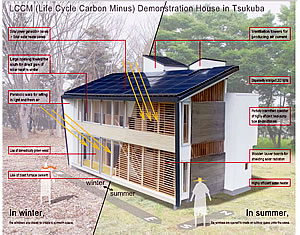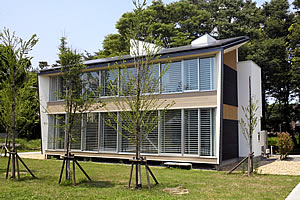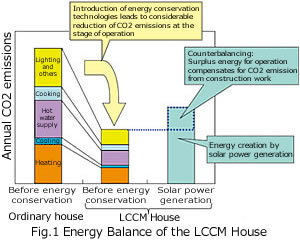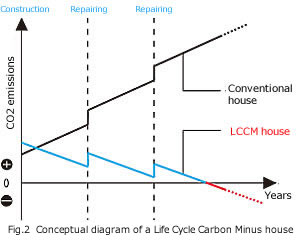|
|
| What is an LCCM house? |
The New Growth Strategy announced by the Japanese government in 2010 sets a long-term target of cutting greenhouse gas emissions by 25 percent from 1990 levels by 2020. However, carbon dioxide (CO2) emissions from residential sector in Japan continued to rise in spite of the progress of heat insulation and air tight in houses and the spread of efficient housing equipments.
In order to achieve the long-term target above, it is critical to reduce CO2 emissions from the residential sector through promoting the further energy conservation in houses.
In such a background, the concept of an LCCM (Life Cycle Carbon Minus) house was proposed as a house which has a long service life, emits the least amount of CO2 for constructing the house, using the house and disposing of the wastes, creates recyclable energy by using solar power generation, etc., and results in a negative life-cycle CO2 emission balance even with the CO2 emission during the construction included.
|

 |
|
Specifically, considerable reduction of energy consumption at the stage of operation and introduction of solar power generation exceeding the consumption make it possible to counterbalance the CO2 emissions from construction. (Fig.1)
However, drastic reduction of energy consumption for operation will degrade health, safety, comfort and convenience. For the widespread use of LCCM house, it is necessary to retain these elements to the maximum degree. |
 |
|
As is shown in Fig.2, CO2 emissions from conventional houses continue to increase the longer they are operated. In contrast, CO2 emissions from LCCM houses decrease with the surplus energy for operation and fall below zero after a period of years, although they rise slightly at the time of renovation. |
 |
| |
>>>The LCCM (Life Cycle Carbon Minus) Demonstration House |
|
| Research system |
Although the concern for LCCM or zero energy houses has risen worldwide, the
research on those technologies is insufficient yet and it is necessary to
clarify the technological potential etc. For this reason, the Building
Research Institute (BRI) started a joint research project titled "Study on
Zero Energy Housing" in 2009 in cooperation with the National Institute for
Infrastructure and Land Management (NILIM) and the Japan Sustainable Building
Consortium (JSBC).
In parallel, the Life Cycle Carbon Minus House Research and Development
Committee (chair: Dr. Shuzo Murakami, Chief Executive of Institute for Building Environment and Energy Conservation) was set up at
JSBC and a three-year R & D project regarding LCCM housing was started in
fiscal 2009 with the support of the Housing Bureau of the Ministry of Land,
Transport and Tourism. |
| Life Cycle Carbon Minus House Research
and Development Committee |
| Chairman |
Shuzo Murakami |
Chief Executive, Institute for Building Environment and Energy Conservation |
| Committee |
Toshiharu Ikaga |
Professor, Keio University |
| |
Yasuo Kuwasawa |
Chief Research Engineer,
Building Research Institute |
| |
Tsuyoshi Seike |
Associate Professor, The University of Tokyo |
| |
Masao Koizumi |
Professor, Tokyo Metropolitan University |
| |
Hiroshi Yoshino |
Professor, Tohoku University |
| |
Hiroki Hondo |
Associate Professor, Yokohama National University |
| |
Masayuki Mae |
Associate Professor, The University of Tokyo |
| |
Manabu Kanematsu |
Associate Professor, Tokyo University of Science |
| |
Ryo Murata |
Assistant Professor, Tokyo Institute of Technology |
| |
Takashi Akimoto |
Professor, Shibaura Institute of Technology |
| |
Yasuyuki Shiraishi |
Associate Professor,
The University of Kitakyushu |
|
| Plan for the future |
"New Growth Strategy" (the Cabinet decision on June 18, 2010) requires a
step-by-step introduction of obligations to meet the energy-conservation
standards for net zero energy/zero emission of housing/building in order to
achieve the target of cutting greenhouse gas emissions by 25 percent from 1990
levels by 2020, and expects that ZEH (zero energy house/zero emission house)
will be made as a standard newly-built house and ZEB (zero energy
building/zero emission building) will be achieved in public buildings by 2020.
BRI will be conducting research to reflect in creating technological standards
necessary to achieve those goals using the study of LCCM houses.
In addition, The Ministry of Land, Infrastructure, Transport and Tourism, the Ministry
of Economy, Trade and Industry, and the Ministry of the Environment jointly
proposed a plan on November 12, 2010 to require all newly-built buildings to
meet the energy-conservation standards by fiscal year 2020. BRI will also
conduct research to reflect in developing the new technological standards. |
|